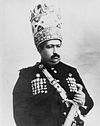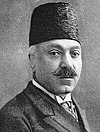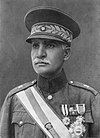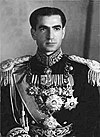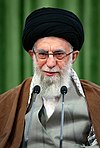Commander-in-Chief of the Iranian Armed Forces
| Commander-in-chief role | |
 | |
 | |
| Vested in | Supreme Leader of Iran |
|---|---|
| Style | Supreme Commander[1] |
| Status | Ultimate authority of the military |
| Residence | House of Leadership |
| Seat | Tehran |
| Constituting instrument | Iranian Constitution |
| Deputy | Minister of Interior (Police)[2] |
The position of Commander-in-Chief (Farmandehe Koll-e Qova (Persian: فرمانده کل قوا), formerly known as Bozorg Arteshtārān (Persian: بزرگارتشتاران) is the ultimate authority of all the Armed Forces of Iran, and the highest possible military position within the Islamic Republic of Iran. The position was established during the Persian Constitutional Revolution. According to the Constitution of Iran, the position is vested in the Supreme Leader of Iran and is held since 1981.
List of Commanders-in-Chief[]
| No. | Portrait | Name (Birth–Death) |
Term of office | Military rank | Military branch | |||
|---|---|---|---|---|---|---|---|---|
| Took office | Left office | Time in office | ||||||
| 1 | Shah Mozaffar ad-Din Shah (1853–1907) | 6 August 1906 | 3 January 1907 † | 150 days | N/A | N/A | ||
| 2 | Shah Mohammad Ali Shah (1872–1925) | 3 January 1907 | 16 July 1909 | 2 years, 194 days | N/A | N/A | ||
| – | Regent Alireza Khan (1847–1910) | 16 July 1909[3] | 22 September 1910 † | 1 year, 56 days | N/A | N/A | ||
| – | Regent Abolqasem Khan (1856–1927) | 22 September 1910[3] | 21 July 1914 | 3 years, 314 days | N/A | N/A | ||
| 3 | Shah Ahmad Shah (1898–1930) | 21 July 1914[3] | 14 February 1925 | 11 years, 147 days | N/A | N/A | ||
| 4 | Prime Minister Reza Khan (1878–1944) [a] | 14 February 1925[4] | 15 December 1925 | 304 days | Brigadier general | Persian Cossack Brigade (1894–1921) | ||
| 1 | Shah Reza Shah (1878–1944) | 15 December 1925 | 16 September 1941 | 15 years, 275 days | Brigadier general | Persian Cossack Brigade (1894–1921) | ||
| 2 | Shah Mohammad Reza Shah (1919–1980) | 16 September 1941 | 21 July 1952 | 10 years, 309 days | Captain[5] | Imperial Iranian Army (1936–1941)[5] | ||
| 3 | Prime Minister Mohammad Mosaddegh (1882–1967) [b] | 21 July 1952 | 19 August 1953 | 1 year, 29 days | N/A | N/A | ||
| (2) | Shah Mohammad Reza Shah (1919–1980) | 19 August 1953 | 11 February 1979 | 25 years, 176 days | Captain | Imperial Iranian Army (1936–1941) | ||
| 1 | President Abolhassan Banisadr (1933–2021) [c] | 19 February 1980[8] | 10 June 1981[9] | 1 year, 111 days | N/A | N/A | ||
| 2 | Supreme Leader Ruhollah Khomeini (1902–1989) | 10 June 1981 | 3 June 1989 † | 7 years, 358 days | N/A | N/A | ||
| 3 | Supreme Leader Ali Khamenei (born 1939) | 4 June 1989 | Incumbent | 32 years, 253 days | N/A[d] | Islamic Revolutionary Guard Corps (24 November 1979–24 February 1980)[10] | ||
References[]
- ^ Appointed by the Parliament of Iran.[4]
- ^ Mosaddegh was granted emergency powers by Shah of Iran to rule by decree.[6] While holding office as the Prime Minister and Minister of War (renamed to "Ministry of National Defence") simultaneously, Mossadegh went over the authority of Shah, the Commander-in-Chief vetted in the Persian Constitution of 1906, and appointed commanders in Imperial Iranian Army and Police.[7]
- ^ Delegated by the Supreme Leader of Iran.[8]
- ^ He was caretaker of the Islamic Revolutionary Guard Corps, the highest position in the corps.[10] At the time military ranks were not used.
- ^ If the Enemy Attacks, He Will Receive a Severe Blow and Counterattacks: Ayatollah Khamenei, The Office of the Supreme Leader, 28 August 2016, retrieved 20 April 2018,
Ayatollah Khamenei, the Supreme Commander of All Armed Forces, met Sunday afternoon with the commanders and officials...
- ^ Saeid Golkar (5 January 2018), Iran's Coercive Apparatus: Capacity and Desire (Policywatch), The Washington Institute for Near East Policy, retrieved 20 April 2018,
The police are under the control of the Interior Ministry, which the constitution has placed under the president's purview. Yet the head of the NAJA is appointed by the Supreme Leader and serves as commander-in-chief of Iran's armed forces, effectively limiting the interior minister's authority to logistical, equipment, and support issues.
- ^ a b c Sheikh-ol-Islami, M. J. (July 28, 2011) [December 15, 1984]. "AḤMAD SHAH QĀJĀR". In Yarshater, Ehsan (ed.). Encyclopædia Iranica. 6. Vol. I. New York City: Bibliotheca Persica Press. pp. 657–660. Retrieved March 15, 2016.
- ^ a b Elton L. Daniel (2012). The History of Iran. ABC-CLIO. p. 136. ISBN 978-0313375095.
- ^ a b Ali Akbar Dareini (1998). The Rise and Fall of the Pahlavi Dynasty: Memoirs of Former General Hussein Fardust. Motilal Banarsidass Publ. pp. 15–16. ISBN 8120816420.
- ^ James Buchan (2013). Days of God: The Revolution in Iran and Its Consequences. Simon and Schuster. p. 64. ISBN 978-1416597773.
- ^ John Prados (2006). Safe for Democracy: The Secret Wars of the CIA. Ivan R. Dee. pp. 102–103. ISBN 1615780114.
- ^ a b Sinkaya, Bayram (2015), The Revolutionary Guards in Iranian Politics: Elites and Shifting Relations, Iranian Studies, vol. 25, Routledge, p. 96, ISBN 9781317525646
- ^ Sinkaya, Bayram (2015), The Revolutionary Guards in Iranian Politics: Elites and Shifting Relations, Iranian Studies, vol. 25, Routledge, p. 88, ISBN 9781317525646
- ^ a b Detailed biography of Ayatollah Khamenei, Leader of Islamic Revolution, Khamenei.ir, 23 September 2013, retrieved 17 March 2016
Categories:
- Military of Iran
- Commanders in chief
- Commanders-in-Chief of Iran

